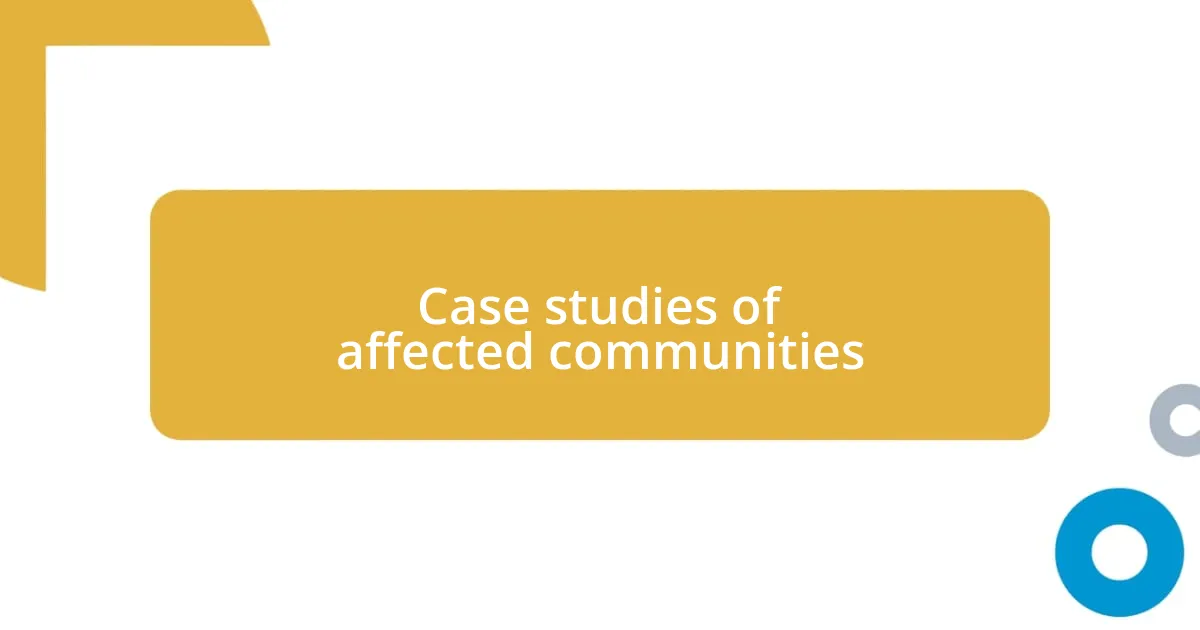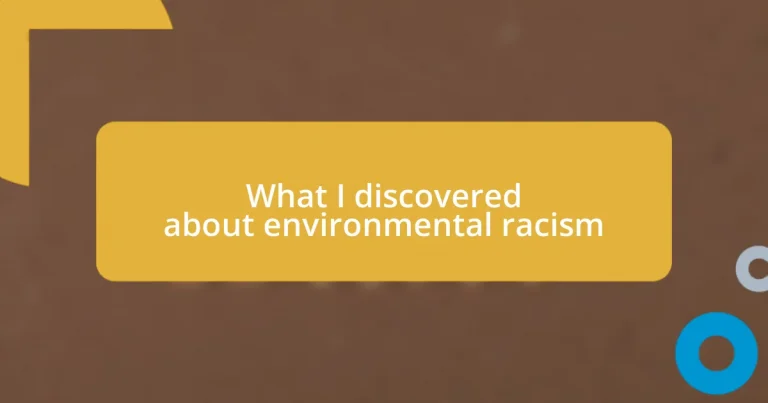Key takeaways:
- Environmental racism disproportionately affects marginalized communities, leading to higher exposure to pollution and related health issues.
- Historical practices like redlining have entrenched systemic inequalities, influencing current health disparities and environmental hazards faced by communities of color.
- Activism and community engagement are crucial in addressing environmental injustices and fostering local solutions.
- Policies like the Environmental Justice Executive Order of 1994 and the Justice40 Initiative aim to address historical inequities but require effective implementation and community involvement to create real change.

Understanding environmental racism
Understanding environmental racism involves recognizing how certain communities, particularly those of color, face disproportionate exposure to environmental hazards. I remember a time in my neighborhood when a toxic waste site was proposed just a few blocks away. It made me wonder: why do these decisions often impact marginalized communities more than others?
As I delved deeper into this topic, I found it heartbreaking to see the correlation between race, poverty, and proximity to pollution. For instance, I learned about neighborhoods where families couldn’t open their windows on a hot summer day due to nearby factories emitting toxic fumes. It makes me reflect—how can we justify putting vulnerable populations at risk like this?
Consider the term “environmental justice.” It struck me how critical it is that everyone has the right to a clean and safe environment. I often think about the children growing up in these communities, who may never get the chance to experience nature without fear. How can we close the gap and ensure all voices are heard in the fight for a healthier planet?

Historical context of environmental racism
The historical roots of environmental racism can be traced back to systemic inequalities and discriminatory policies that have spanned generations. For example, during the 1930s, redlining practices in urban areas systematically denied Black families access to housing in safer neighborhoods, leading to a concentration of pollution and hazards in their communities. Reflecting on this, it’s chilling to think about how those decisions still affect generations today, perpetuating cycles of health disparities.
In the 1980s, the phenomenon gained national attention as activists began connecting pollution with race. I recall reading about a pivotal moment when residents of Warren County, North Carolina, protested against the dumping of toxic waste in their predominantly Black community. Their fight opened my eyes to just how long communities have been standing up against such injustices. Realizing that their battle was one of many made me appreciate the resilience these communities exemplify.
To me, understanding this context of environmental racism isn’t just about history; it’s a call to action. I often ponder: how can we learn from these past injustices to create a more equitable future? It’s evident that recognizing past mistakes is crucial to ensure vulnerable populations don’t bear the brunt of future environmental decisions. Communities today still face similar threats, and knowing their history empowers us to fight for change.
| Time Period | Significant Events |
|---|---|
| 1930s | Redlining practices deny Black families access to safer neighborhoods. |
| 1980s | Warren County protests against toxic waste dumping highlight environmental racism. |

Case studies of affected communities
When I think about communities affected by environmental racism, the stories of Flint, Michigan, and the water crisis stand out vividly. Residents, largely from marginalized backgrounds, faced tainted water due to lead pipes and mismanagement. It’s painful to imagine families being unable to trust the very water they drink and bathe in every day. I often reflect on how this crisis is more than just a public health issue—it’s a stark reminder of systemic neglect.
Some other poignant examples of affected communities include:
- Cedar Rapids, Iowa: After severe flooding, predominantly low-income neighborhoods suffered the worst, as they were located in flood-prone areas due to a lack of investment in infrastructure.
- New Orleans, Louisiana: Post-Hurricane Katrina, predominantly Black neighborhoods struggled with inadequate recovery efforts, highlighting how racial inequities influenced disaster response.
- Warren County, North Carolina: The protests against the toxic waste landfill in the 1980s were a significant moment that united residents to demand environmental justice, an echo of ongoing struggles.
These stories resonate on a personal level, reflecting a shared human experience that should never be overshadowed by racial or economic barriers. It’s this resilience that inspires me to keep advocating for change.

Health impacts of environmental racism
The health impacts of environmental racism are profoundly alarming. For instance, when I learned about the high rates of asthma among children in urban areas polluted by factories, I couldn’t help but feel a deep sense of injustice. It’s heartbreaking to think that where you live can dictate not only your environment but also your access to clean air. Have you ever thought about how your ZIP code might influence your health?
Research shows that communities of color often bear a heavier burden of health issues linked to hazardous waste sites and poor air quality. I recall speaking with a friend who grew up in a neighborhood next to a landfill. She shared how her family frequently battled respiratory problems, and it struck me that many families face this brutal reality daily. It’s not just about statistics; these are real lives impacted by decisions made far from their communities.
Moreover, the lack of access to healthcare resources compounds these existing health issues. Residents in affected areas often encounter barriers when seeking medical help, from transportation hurdles to financial constraints. Reflecting on this, I often wonder: how many people suffer in silence simply because the system is stacked against them? It’s a dire situation that needs urgent attention and action from all of us who care about health equity.

Policies addressing environmental injustice
Policies aimed at addressing environmental injustice often seek to rectify historical inequities. One notable example is the Environmental Justice Executive Order of 1994, which directs federal agencies to consider the impacts of their actions on minority and low-income communities. I can’t help but think about how this was a step in the right direction, yet actual implementation remains a challenge. Are policies enough if they don’t translate into real changes for those who need them most?
Local governments are increasingly recognizing the need for equitable policies, like the creation of green zones and the allocation of resources for community improvements. For instance, when cities implement policies that prioritize funding for parks and public spaces in underserved neighborhoods, it creates a tangible shift toward equity. I remember visiting a community park revitalization project, where residents actively participated in design decisions. It was remarkable to see how empowered they felt in shaping their environment, emphasizing that policy is more impactful when communities are at the forefront.
Legislation, such as the Justice40 Initiative, aims to ensure that 40% of federal investments in climate and clean energy benefit disadvantaged communities. I wonder how much stronger our collective voice could be if we all engaged with these initiatives, pushing for transparency and accountability. After all, genuine change is only achieved when affected communities have a seat at the table and can influence the policies that dictate their environment and health.

Community activism and solutions
Activism at the community level is crucial in combatting environmental racism and fostering real change. I remember attending a local town hall meeting where residents passionately voiced their concerns about a proposed waste facility in our neighborhood. The energy in the room was palpable, and I realized that when people unite for a common cause, their collective power can challenge even the most entrenched interests. It made me reflect—how often do we underestimate the strength of our voices when we stand together?
In my experience, grassroots movements are often the backbone of effective solutions. When I volunteered for an environmental justice group, I saw firsthand how education and awareness could empower community members. We organized workshops to teach residents about their rights and how to advocate for cleaner air and water. This experience taught me that knowledge is not just power; it’s also a catalyst for change. What if more communities around the country adopted similar initiatives?
Collaboration is key, not just within communities but also between them and local governments. During one project, we partnered with city officials to develop a community garden that emphasized sustainable practices and provided fresh produce. This endeavor not only beautified an abandoned lot but also sparked conversations about environmental equity and health. It hit me then—that solutions often arise from connections, and by fostering these relationships, we can create a healthier, more equitable environment for all. What innovative ideas could blossom if communities felt supported in their activism?














